Development teams face constant pressure to ship valuable features faster. Yet, traditional, linear project plans often break down when faced with shifting market needs, new customer feedback, or unexpected technical hurdles. An Agile workflow provides a structured yet flexible approach to navigate this complexity. By breaking work into short, iterative cycles, teams can adapt to change, collaborate more effectively across departments, and consistently deliver working software.
This guide walks through everything you need to build and refine your team’s Agile process. We will explore the core principles of Agile, compare different frameworks like Scrum and Kanban, and outline the key steps for successful implementation. You will also learn how to overcome common challenges and leverage modern platforms to gain the visibility and control needed to ship with confidence.
Try monday devKey takeaways
- Agile workflows break work into short 1-4 week cycles, letting teams deliver working features quickly and adapt to changes instead of waiting months for final products.
- Start small with one team using a framework like Scrum or Kanban, then scale gradually based on what works for your specific culture and project needs.
- Focus on cross-functional collaboration and continuous feedback rather than rigid documentation — daily communication prevents problems and keeps everyone aligned on goals.
- AI-powered features now automate routine activities like sprint planning and risk detection, freeing teams to focus on creative problem-solving and faster delivery.
- Flexible, customizable workflows like those in monday dev adapt to your team’s unique process while giving stakeholders real-time visibility without slowing down developers.
What is an Agile workflow?
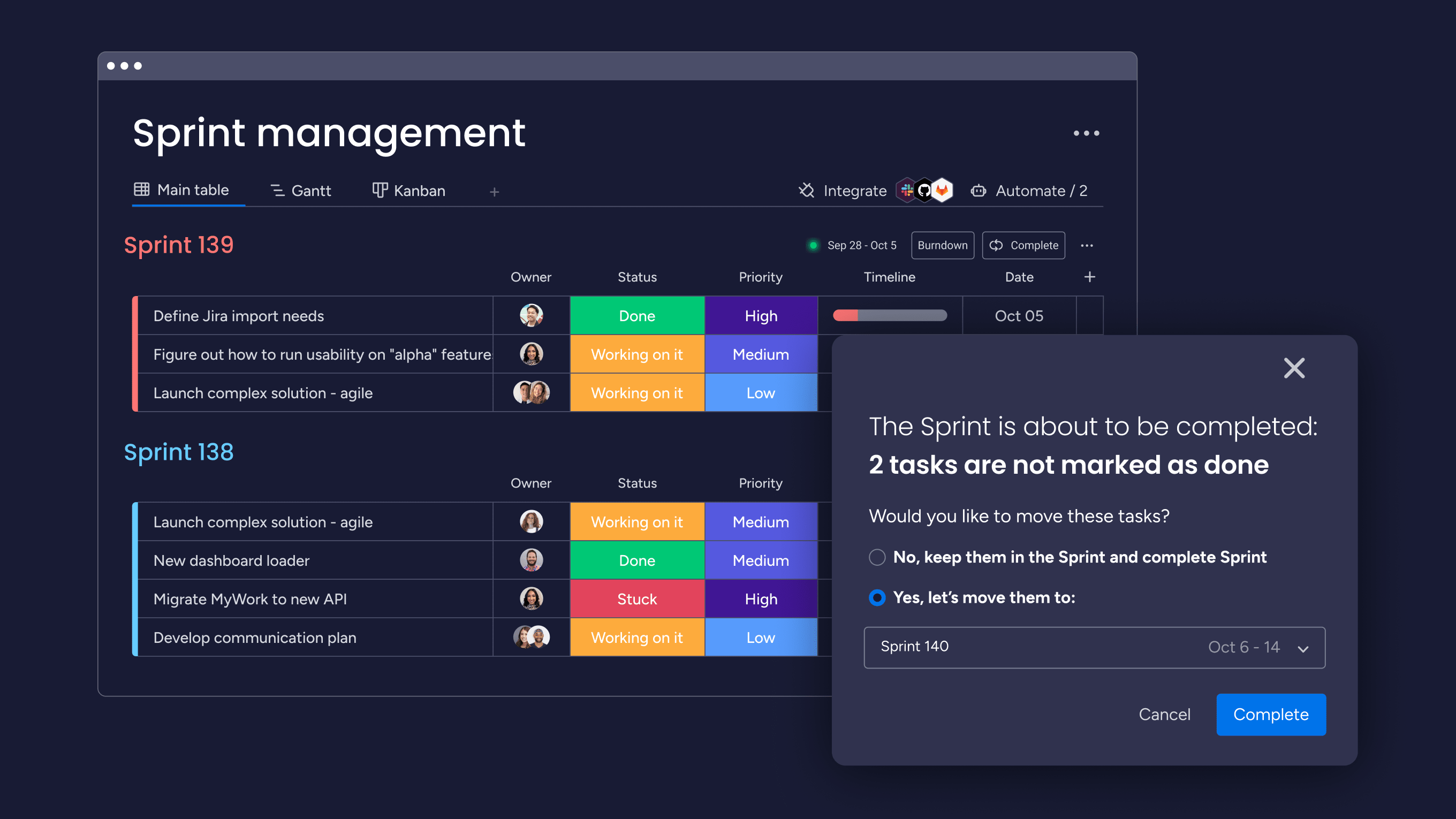
An Agile workflow is a project management approach that breaks work into short, iterative cycles called sprints. For decades, these methods have greatly increased success rates in software development, allowing teams to deliver working software every few weeks instead of waiting months for a finished product.
Think of it like building a house room by room, getting feedback after each room is complete, rather than waiting until the entire house is finished to see if it meets your needs. Teams work in cycles that typically last 1-4 weeks, where they plan, build, test, and review their work before starting the next cycle.
This iterative model is defined by a few core principles that set it apart from traditional approaches. Understanding these characteristics is key to adopting an Agile mindset.
- Iterative development: Work happens in repeated short cycles rather than one long project.
- Cross-functional collaboration: Developers, designers, and business stakeholders work together daily.
- Continuous feedback: Regular reviews and adjustments based on what you learn.
- Adaptive planning: Plans change based on new information instead of following a fixed path.
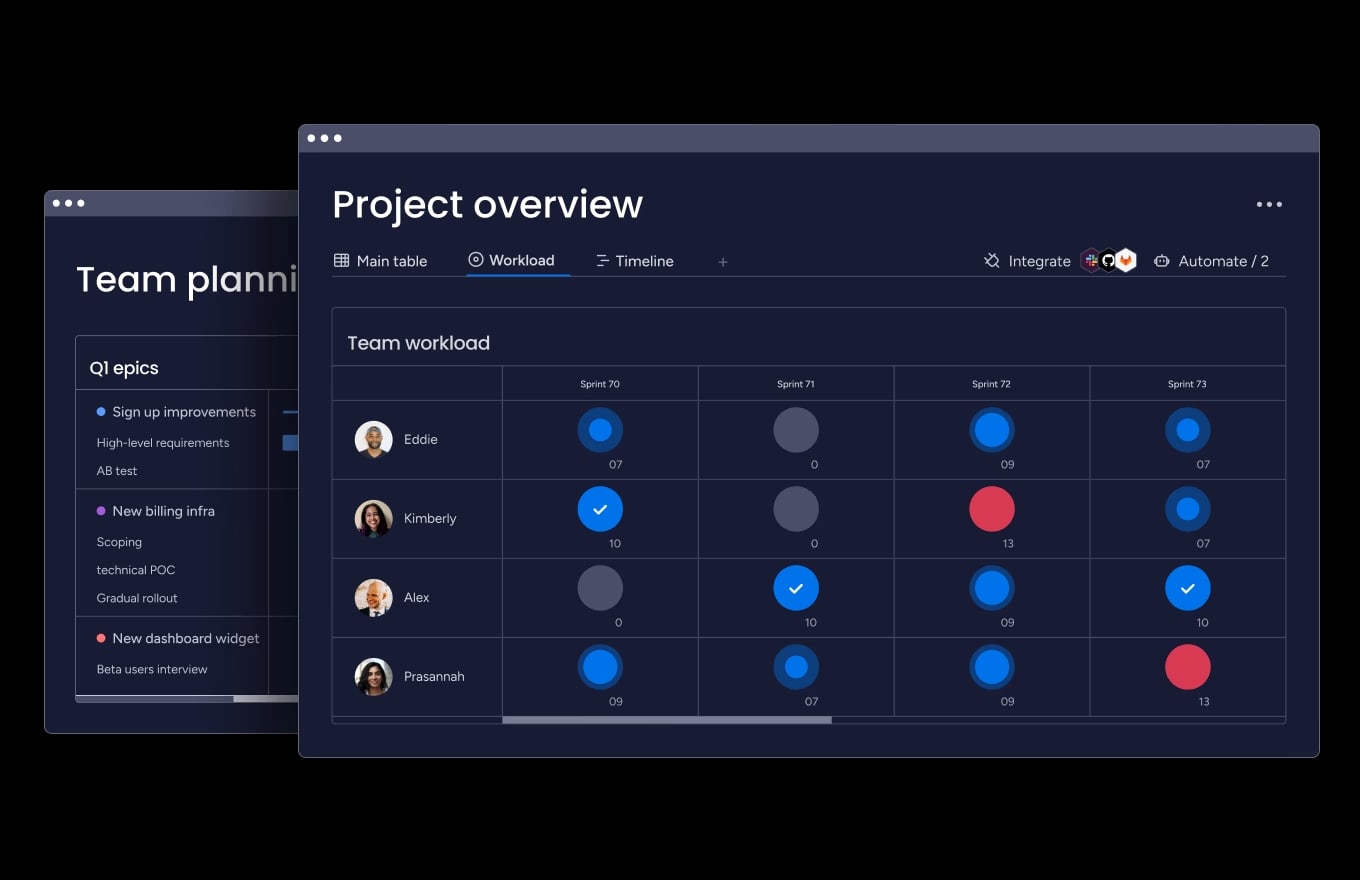
Agile workflow vs. traditional project management
Traditional project management follows a Waterfall approach where each phase must finish before the next begins. You complete all requirements, then all design, then all development, then testing, and finally deployment.
Agile workflows take a completely different approach. Instead of doing all planning upfront, you plan a little, build a little, test a little, and get feedback — then repeat.
The differences become clear when you compare their core functions side-by-side. This contrast highlights why Agile is so effective at managing uncertainty and delivering value early.
Try monday devBenefits of Agile workflows for development teams
Agile workflows transform how teams deliver value by enabling faster adaptation and more frequent delivery, which sets them apart from other software development methodologies. The following benefits compound over time as teams mature in their Agile practices, guided by Agile values.
- Increased flexibility and adaptability: Short sprints let you change direction quickly when priorities shift. If market conditions change or customers request different features, you can adjust within weeks rather than months.
- Enhanced team collaboration: Daily standups and regular reviews keep everyone aligned. Developers work in close partnership with designers, testers, and product managers throughout each sprint. This constant communication reduces misunderstandings and catches problems early.
- Faster time to market: Delivering working features every sprint means customers get value sooner. You can release a basic version, gather feedback, and improve it rather than guessing what users want. Early releases also mean revenue starts flowing sooner to fund continued development.
- Improved visibility and transparency: Everyone can see sprint progress through boards and burndown charts. Stakeholders receive frequent updates and see demonstrations every sprint.
- Higher customer satisfaction: Regular feedback ensures you’re building what customers actually need. Instead of delivering based on outdated requirements, you adapt based on real usage. This continuous alignment with customer needs leads to products people actually want to use.
6 Agile workflow types (with examples)
Different Agile frameworks suit different situations. Understanding these options helps you pick the right approach for your team’s specific needs and culture.
1. Scrum
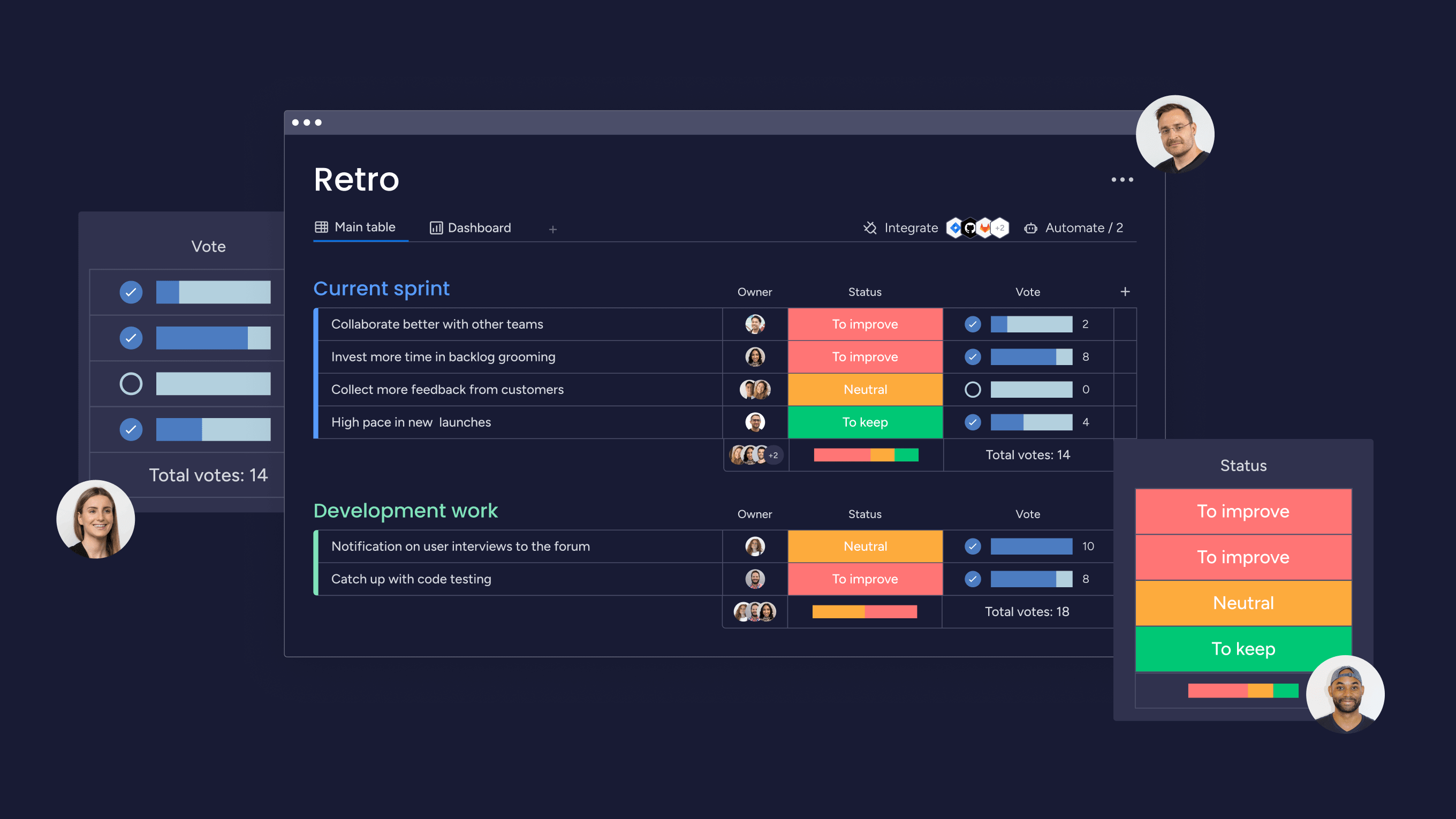
Scrum uses fixed-length sprints of 2-4 weeks with specific roles and ceremonies (Scrum methodology). You’ll have a product owner who decides what to build, a Scrum master who helps the team work effectively, and the development team who creates the product. This framework includes 4 key meetings (Agile ceremonies):
- Sprint Planning to choose work
- Daily Standups for quick updates
- Sprint Review to show completed work
- Sprint Retrospective to improve your process
For example, a software team might use Scrum to deliver new app features every two weeks, reviewing each sprint with stakeholders.
2. Kanban
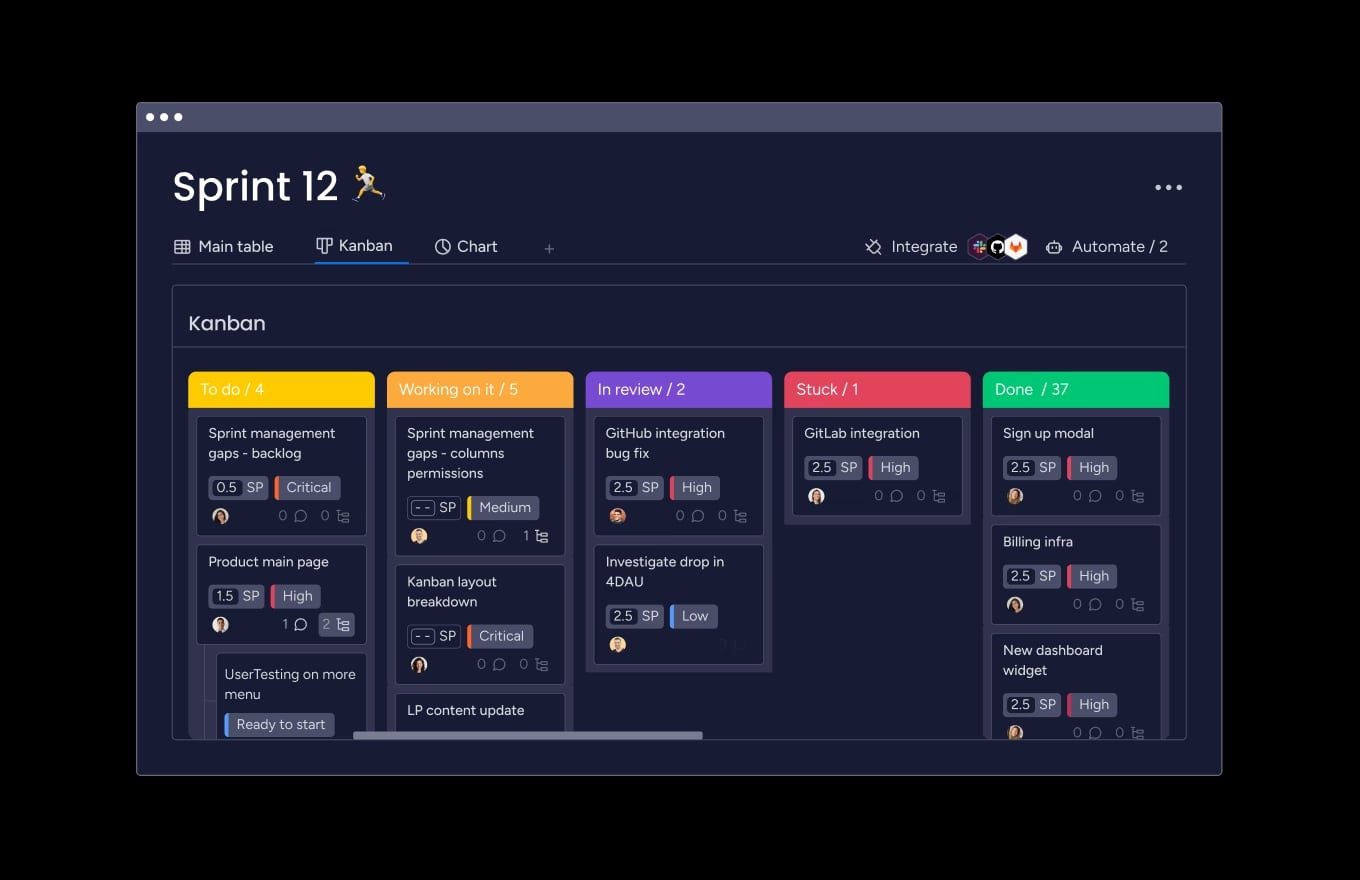
Kanban visualizes your workflow on a board with columns like “To Do,” “In Progress,” and “Done.” Work flows continuously without fixed sprints, and the key is limiting work-in-progress (WIP) to prevent overload. If your “In Progress” column has a limit of 3 items, you can’t start new work until something moves to “Done.”
An example of this would be a customer support team that visualizes open tickets on a Kanban board to limit work in progress and improve response times.
3. Extreme Programming (XP)
Extreme Programming (XP) emphasizes technical excellence through specific practices. Teams write tests before code, work in pairs, and integrate code changes multiple times daily, aligning well with Agile testing principles.
For example, an engineering team working on a financial app might use XP to ensure reliable, test-driven code with continuous integration. This approach works best when code quality is critical and your team values engineering practices.
4. Feature-driven development
FDD organizes work around specific features using 5 steps: develop overall model, build feature list, plan by feature, design by feature, and build by feature. Larger teams working on complex systems often prefer this structured approach, which can be part of an Agile software development life cycle.
Consider a large e-commerce project that is planned by feature, such as building the search function or payment system in self-contained steps.
5. Crystal
Crystal adapts to your team size and project risk. Crystal Agile methodology includes Crystal Clear for small teams, while Crystal Orange handles larger groups. Let’s say a startup chooses Crystal Clear to zero in on collaboration and frequent delivery without heavy process overhead. The focus stays on people and communication rather than rigid processes.
6. Agile unified process
AUP simplifies traditional development with 4 phases that each use Agile practices:
- Inception
- Elaboration
- Construction
- Transition
Teams familiar with phase-based approaches find this transition to Agile more comfortable. For example, an enterprise IT team might transition from Waterfall by applying AUP to modernize its internal software systems.
5 steps for implementing Agile workflows
Starting with Agile requires thoughtful planning but doesn’t need to be overwhelming. These steps guide you through a practical implementation that grows with your team.
Step 1: Choose your Agile framework
Look at your team size, project type, and company culture. Small teams often start with Scrum for its clear structure. Teams handling support requests might prefer Kanban’s continuous flow.
Run a pilot project with your chosen framework before expanding. monday dev provides templates for different frameworks, making it easy to experiment.
Step 2: Build cross-functional teams
Include all skills needed to deliver working features. A typical team has developers, testers, a designer, and someone who understands the business needs.
Keep teams small — usually 5-9 people — for effective communication. Larger groups struggle with coordination.
Step 3: Create your product backlog
List all features and improvements you want to build. Write them as user stories: “As a customer, I want to filter search results so I can find products faster.”
Prioritize based on customer value and business impact. Regular grooming keeps your backlog current and relevant.
Step 4: Plan your first sprint
Select enough work for your team to complete in one sprint. Consider team capacity and aim to finish early, as this builds momentum and trust.
Define a clear sprint goal that explains what you’ll accomplish. This focus helps when making decisions during the sprint.
Step 5: Establish continuous improvement
End each sprint with a retrospective to discuss what worked and what didn’t. Make small improvements each time rather than trying to fix everything at once.
Track simple Agile metrics like stories completed to see if changes help. The goal is steady improvement, not perfection.
Try monday devAgile workflow best practices
Successfully implementing Agile workflows requires more than just following a framework. The following proven practices help teams avoid common pitfalls and maximize the benefits of Agile development:
- Start small and scale gradually: Begin with one team to build confidence and learn what works in your organization. Success stories from this pilot team help convince others to try Agile. Large organizations might need frameworks like SAFe to coordinate multiple Agile teams.
- Prioritize communication over documentation: Focus on conversations that solve problems rather than writing detailed specifications, reflecting core Agile principles. A quick video call often resolves issues faster than long email chains. Document decisions and reasons, not every detail.
- Embrace change and iteration: Treat changing requirements as normal, not disruptive. Your backlog should evolve based on what you learn each sprint. Build flexibility into your planning and leave room for urgent requests without derailing your sprint goals.
- Measure outcomes not output: Track customer satisfaction and feature adoption, not just stories completed. The goal is to deliver features that customers actually use and value. Use velocity for planning, not comparing teams — each team’s context is different, making comparisons meaningless.
How AI enhances Agile workflows
AI enhances Agile practices by automating routine work and providing insights that help teams make smarter decisions, a trend that’s taking hold as IT professionals lead the charge in AI adoption. These capabilities let teams focus on creative problem-solving.
Automated sprint planning and prioritization
AI analyzes your team’s history to suggest realistic sprint commitments. It considers past velocity, story complexity, and team availability.
Intelligent prioritization weighs multiple factors — customer feedback, technical dependencies, business value — to recommend the best work sequence. monday dev’s AI features can categorize new requests and assign them to the right team automatically.
Predictive analytics for team velocity
Machine learning tracks patterns in your team’s performance to forecast completion dates more accurately. It accounts for factors like team changes and technical complexity.
These predictions help set realistic expectations with stakeholders and identify risks before they impact delivery.
Intelligent work assignment
AI matches work to team members based on their skills and current workload. This ensures people work on tasks that suit their strengths while balancing the overall workload.
The system learns from outcomes, improving its recommendations over time.
Real-time risk detection
AI monitors velocity trends, code quality metrics, and team communication patterns to spot potential problems early. You might see velocity declining before it becomes obvious.
Early warnings let you address issues proactively rather than reacting to crises.
Common Agile workflow challenges and solutions
Every Agile transformation faces obstacles. Understanding the following challenges helps you prepare solutions before problems derail your progress.
Breaking down silos between teams
Traditional organizations separate development, QA, and business teams. Agile requires them to work together daily, which challenges established boundaries.
Solution: Create cross-functional teams with shared goals. Use platforms like monday dev to maintain visibility across teams. Regular demos and planning sessions help different groups understand each other’s work.
Managing remote Agile teams
Distributed teams struggle with the close collaboration Agile requires. Time zones and technology barriers can reduce communication effectiveness.
Solution:Establish core hours when everyone is available. Use video for important ceremonies and create clear asynchronous communication practices. Digital boards become essential for maintaining shared understanding.
Scaling Agile across the enterprise
Coordinating multiple Agile teams requires new structures. Without proper frameworks, teams optimize locally while creating conflicts elsewhere.
Solution: Implement portfolio planning sessions where teams align on shared objectives. Create communities of practice for sharing knowledge. Leadership must support the cultural changes required.
Overcoming platform limitations
Rigid platforms force teams into predefined workflows that don’t match how they actually work. This friction reduces Agile effectiveness and contributes to the software adoption challenges seen in large enterprises.
Solution: Choose flexible platforms that adapt to your process. monday dev lets teams customize workflows, views, and automations to match their unique needs while maintaining coordination.
Try monday devTransform your Agile workflow with monday dev
With monday dev, development teams gain the flexibility to implement Agile workflows that match your team’s unique processes while providing visibility across the organization.
Flexible workflows that adapt to your process
Create boards that match how your team actually works. Whether you use Scrum, Kanban, or something unique, customize columns, automations, and views to support your process. Leverage monday dev’s sprint planning features to allocate work, set story points, and track progress all in one place.
Start with proven templates and modify them based on what you learn. Your workflows can evolve without requiring platform changes or complex migrations, and monday dev’s drag-and-drop interface makes it simple to reorganize your backlog and adjust priorities as requirements change.
Real-time visibility without slowing teams
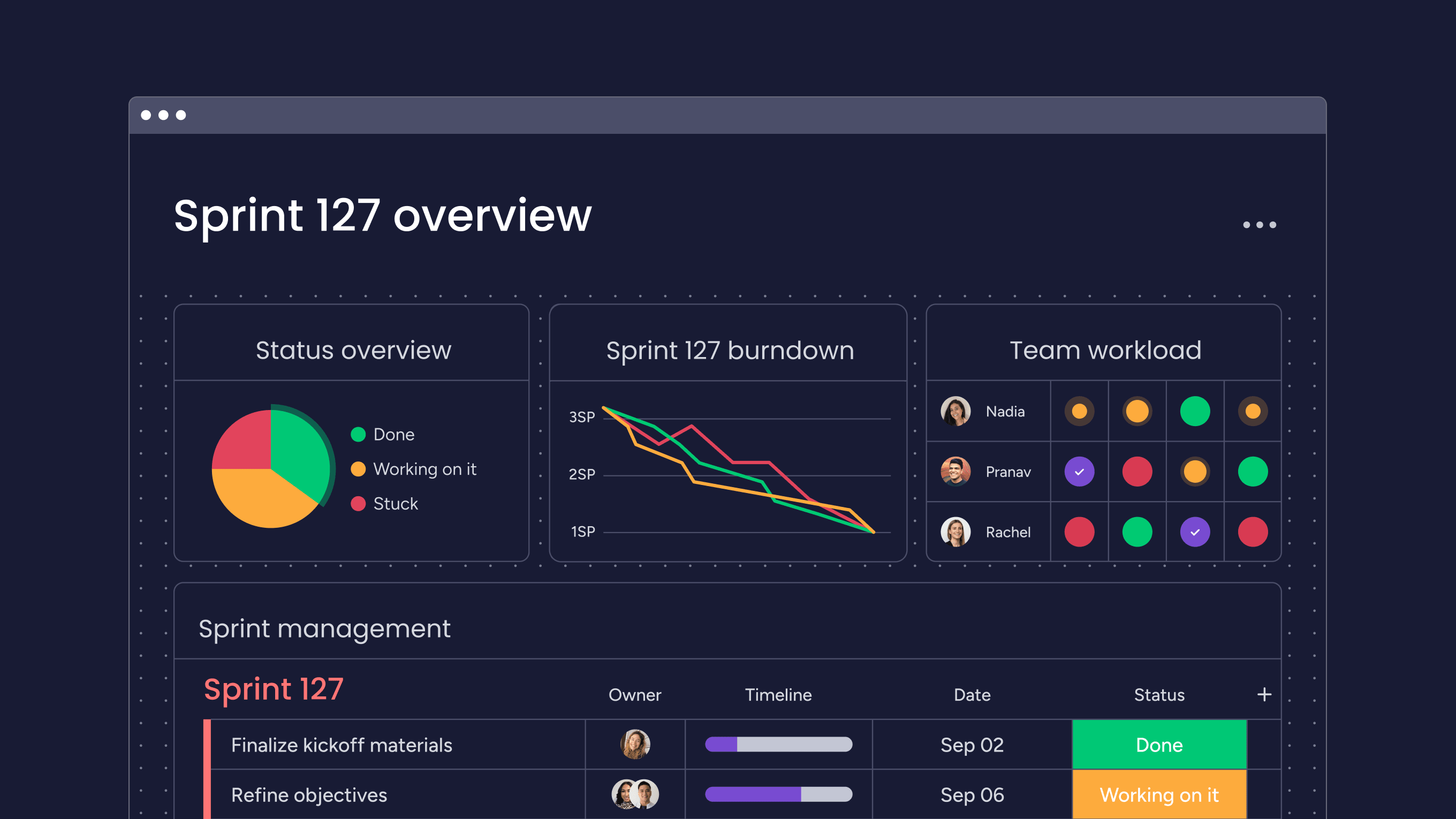
Automated dashboards show progress without requiring manual updates from developers. Stakeholders see burndown charts, velocity trends, and delivery forecasts that update based on actual work. With monday dev’s customizable widgets, you can build executive dashboards that highlight the metrics that matter most to your organization.
This transparency builds trust while letting teams focus on delivery rather than reporting. Set up automated status reports that notify stakeholders of sprint progress without interrupting your development team’s flow.
Seamless integration across your tech stack
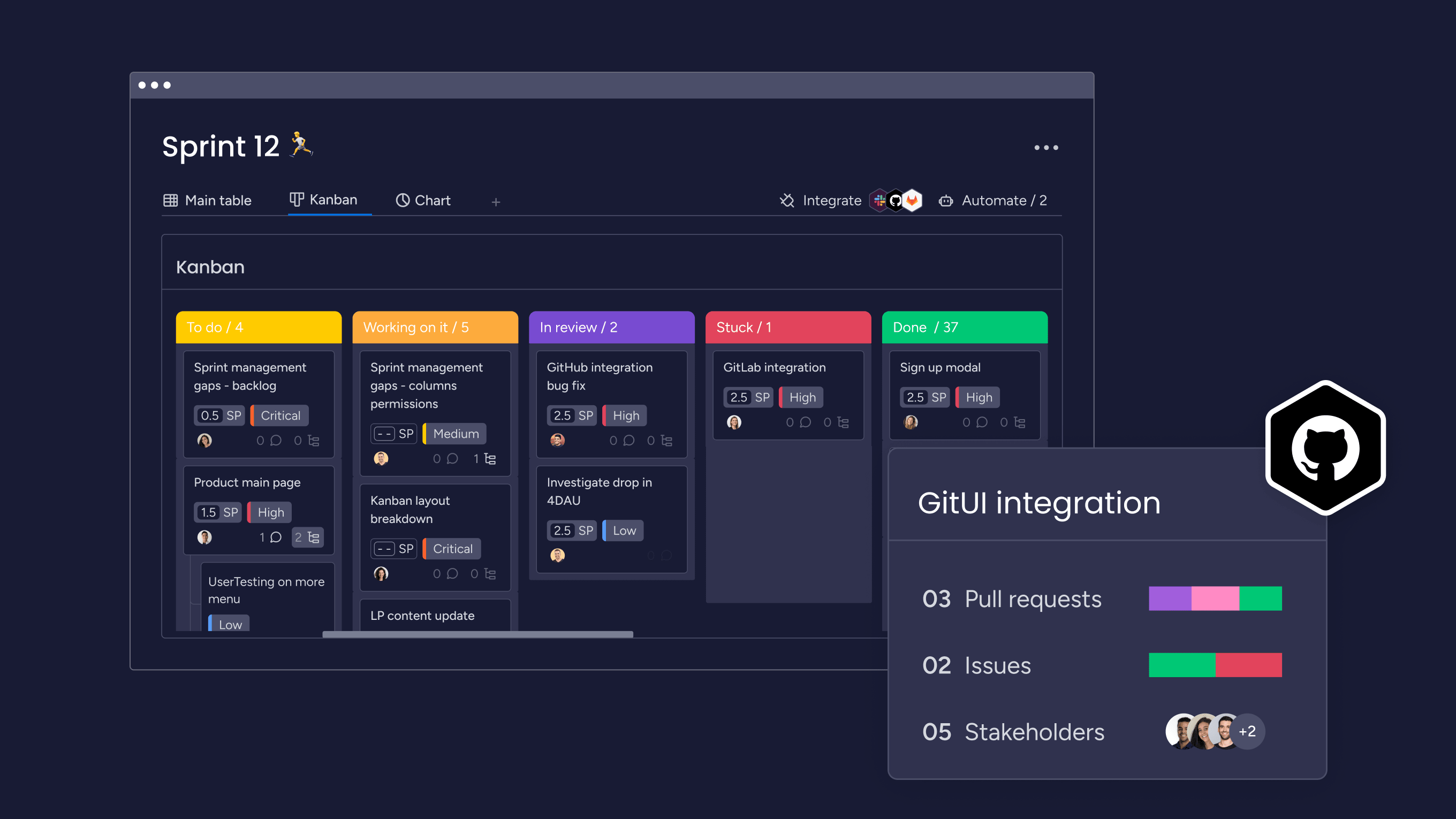
Connect with Git repositories, CI/CD pipelines, and communication platforms. monday dev’s native integrations with GitHub, GitLab, Jira, and Slack ensure work stays synchronized across systems without manual updates. Pull request statuses update automatically, and code commits link directly to your user stories.
These integrations mean teams can use their preferred development platforms while maintaining visibility in monday dev. The platform’s open API also allows for custom integrations with virtually any tool in your development ecosystem.
Build better software with Agile workflows
Agile workflows give development teams the structure and flexibility needed to thrive in today’s fast-paced environment. By breaking work into manageable sprints, fostering cross-functional collaboration, and embracing continuous feedback, teams can deliver value faster while adapting to changing requirements with confidence.
The key to success lies in starting small, choosing the right framework for your team’s needs, and continuously refining your process based on what you learn. Smart platforms like monday dev make implementing Agile workflows easier by providing the flexibility to match your unique process while maintaining visibility across your organization.
With customizable boards, automated reporting, and seamless integrations with your existing tools, your team can focus on building great software instead of managing processes. Get started today.
Try monday devFAQs
What are the 5 steps of Agile methodology?
The 5 steps of Agile methodology are requirements gathering, design and planning, development and coding, testing and quality assurance, and deployment and review. These steps repeat in short cycles called sprints, typically lasting 1-4 weeks.
What are the 5 Cs of Agile methodology?
The 5 C's of Agile methodology are Communication, Collaboration, Customer Focus, Continuous Improvement, and Courage. These values guide teams in making decisions and working together effectively throughout the development process.
What are the 4 Cs of Agile project management?
The 4 C's of Agile project management are Communication, Collaboration, Creativity, and Confirmation. These principles help teams deliver value consistently while navigating uncertainty and changing requirements.
How long should an Agile sprint typically last?
Agile sprints typically last 1-4 weeks, with 2-week sprints being most common. The sprint length should stay consistent once chosen to help teams develop a predictable rhythm.
Can Agile workflows work for non-technical teams?
Yes, Agile workflows work effectively for marketing, HR, operations, and other non-technical teams. The principles of iterative work and continuous feedback apply to any project with changing requirements.
What is the difference between Agile and Scrum workflows?
The difference between Agile and Scrum workflows is that Agile is an overarching philosophy with core principles, while Scrum is a specific framework with defined roles, ceremonies, and artifacts. Scrum is one way to implement Agile workflows, but teams can also use Kanban, XP, or other frameworks.

